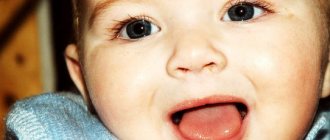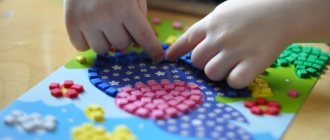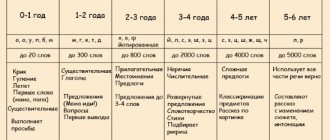Early childhood (2-3 years) is an important stage in the development of a child’s speech.
At this time, children are interested in everything that happens around them.
It is important for parents to support their child in every possible way in his endeavors, because the main guides to the world of new information are the adults in the immediate environment.
Where to begin?
You need to make sure that the child is developing normally physically and emotionally.
There are conventional norms for the development of children (height, weight, skills, abilities, vocabulary of the child).
They should be taken into account, but you shouldn’t get hung up on discrepancies.
It is better to contact a specialist who will compare all the factors influencing development and give a professional assessment of your child’s development.
When you can't wait
Parents should closely monitor their child's development. Undoubtedly, there are so-called variants of the norm and some deviations from the classical tables are quite possible. However, there are a number of signs that should give you concern:
- A four-month-old baby does not respond to the appearance of adults. Doesn't smile when seeing loved ones. No partying.
- By 6-7 months, babbling and repeated syllables meaning a specific word - “ta-ta-ta”, “na-na-na” and others – did not appear.
- At one and a half years old, the baby still does not even say simple words like “mom”, “dad”, “give”. Doesn’t understand simple requests like “come to me”, “bring a teddy bear”.
- At 2 years old, his vocabulary consists of only a few simple words.
- By the age of 2.5 years, the vocabulary is no more than 20 words and the child does not make sentences from them.
- By the age of 3, the child does not understand simple explanations and does not know the names of body parts.
- At 3 years of age, a speech pathologist expects to hear at least 1000-1500 different words and speech consisting of complex sentences. If the baby does not demonstrate this, then it makes sense to consult a specialist.
It happens that a child speaks, but in his own language. Undoubtedly, at this age he has the right to “bo-bo” and “woof-woof” instead of a dog, and even to some incomprehensible word that means something completely different in sound. However, such words should not constitute his entire vocabulary. If a 3-year-old child is understood only by his mother, this is also a reason to turn to specialists.
Features of speech therapy at 2-3 years
The main task of an adult when working with young children is to evoke onomatopoeia in any form.
Taking into account the psychology of children 2-3 years old, classes should be conducted in the form of outdoor games, varied and not long in time.
It is important to establish emotional contact with the child, interest him, gain trust, encourage activity, and praise.
This will help avoid many psychological problems associated with fear of speech.
Speech therapy assistance in Constellation
Speech therapy for children 3 years old is one of the areas of work of our center. Caring parents understand the importance of proper speech development, but they do not always know what to pay attention to without the help of a speech therapist. You need to start by determining the general level of speech development. An experienced speech therapist will identify the development of phonemic hearing and the peculiarities of pronunciation of sounds. Speech therapy lessons for children 2-3 years old contribute to the development of literate, beautiful and clear speech. In the process of speech therapy classes, the general horizons and vocabulary of children are expanded, thinking, personal qualities, and abilities for self-knowledge and self-development are formed. Thanks to the help of a speech therapist, your baby will become assiduous, learn to manage his attention and consciously perceive information.
Development of general imitation
General imitation is the copying of movements, actions, and facial expressions.
The child reproduces the movements he sees and successfully remembers them when repeated many times.
The mechanism of imitation works on a subconscious level in everyday life, and educators and speech therapists use it consciously when conducting classes with children.
It is important that the child is in the correct speech environment, i.e. it is better to limit communication with people who have speech defects. Watch your behavior - words should not contradict actions.
The development of general imitation begins with the repetition of elementary movements, then perform several actions simultaneously. The next stage is the implementation of a whole chain of actions that are logically connected and, as a rule, socially significant (for example, feeding a doll and putting it to bed).
When working with children, follow some rules: your sentences should be clear, simple and not too long; the speech of an adult is emotionally bright, calm, not loud.
General imitation games can be played with one child or with several (usually 3-5 children).
But! Keep in mind that when playing in a group, children imitate not only the adult, but also each other.
Games with general imitation
- Let's do exercises. The point of the game is to follow the adult’s commands (hands up, arms to the sides, jumping, clapping). To maintain interest and attention, invite the children to choose a leader from among themselves.
- Birds. Children play birds. An adult comments on every movement: “We fly like birds! Let's flap our wings up and down! Now the birds are pecking at the grains!” Gradually the pace of the game increases.
- Palms. A series of movements with the palms is performed:
“Palms up (put your palms on the table with the outer side down)!
Palms down (turn your palms over)!
And now put them on their sides (put our palms on their edges)!
And we clenched our fists (we clasp our palms into fists)!”
At first the movements are performed slowly, then faster and without the participation of an adult.
Speech imitation
A child’s reproduction of sounds, words, and phrases is called speech imitation.
It is meaningful only when speech is closely related to the child’s actions.
An adult should stimulate the child's speech with questions.
Words to be repeated must be pronounced many times; do not repeat the child’s “substitute words.” The child’s answers are accepted in any form.
The most important thing is to do everything possible so that the child does not hesitate to speak.
Speech imitation goes through several stages:
- Copying sounds that have a certain meaning.
- Repetition of amorphous words (kup-kup - swim, am-am - eat, lalya - doll).
- Repetition of simple words (baba, grandfather, drink).
- Repeating short phrases: “Give me the juice!” Where's the spoon?
Pay great attention to the use of verbs. If a child’s speech contains many action words, his level of development is quite high.
Games with speech imitation
An effective way to induce speech imitation is the use of poetic texts - finishing words and phrases by creating pauses when reading poetry.
For example:
They love... (monkeys) very much
Eat sweets... (bananas).
We are like monkeys... (look like)
And we love bananas... (too).
Gradually, the number of pauses (words skipped by adults) can be increased, thereby increasing the child’s vocabulary.
Fun games in the form of a conversation: an adult repeats a word several times, then asks the child a question, the answer to which is the highlighted word. If the question is answered correctly, the adult praises the child; if the question is answered incorrectly, he answers the question himself or offers several answer options.
Development standards for two-year-old children
Two years of age is the earliest stage of development at which higher mental functions begin to form. The baby's capabilities will certainly differ from those of 4-year-old children. At this age, the child actively develops thought processes, memory and attention. He can consciously listen to short fairy tales, and also repeat simple words and phrases after his parents. The baby is just learning about the world around him.
By about two years, the baby develops a small vocabulary. The child actively uses it. The lion's share of the vocabulary consists of verbs and nouns. Children also understand general categories (food, toys, people, etc.). Abstract concepts (joy, fear, sympathy, etc.) are not yet susceptible to them.
Signs of speech delay:
- the child has difficulty constructing phrases;
- the baby does not give answers even to simple questions;
- when trying to pronounce certain sounds, twitching or tension of the facial muscles is observed;
- fine motor skills are poorly developed (the child cannot assemble a pyramid, matryoshka, etc.).
All these signs are a cause for concern, so it is better to consult a specialist. The speech therapist will conduct a diagnosis that will confirm or refute suspicions.
The role of the book
The book introduces the child to the world around him; develops logical and imaginative thinking, memory, imagination; expands vocabulary; teaches you how to write sentences correctly.
Through reading, a child learns to listen and concentrate.
Family reading is a way of communication between parents and children, a good method of education and a means of leisure.
Psychologists believe that children to whom their parents read books are more emotionally balanced and self-confident.
Book material for classes
The main features of a good book for a 2-3 year old child:
- High quality illustrations.
High-quality images attract the child and do not move his attention beyond the boundaries of the picture. In high-quality publications, the drawings are usually bright, clear, “spacious” (on a light background, for better visual perception of the child), realistic, and the images of the characters’ bodies are proportional. High-quality illustrations develop the baby’s aesthetic taste. Communication with a book for a child is the first acquaintance with the world of art.
- Conciseness of the text.
At 2-3 years old, children cannot yet listen to long fairy tales, so short rhythmic works (poems, songs, ditties, counting rhymes, riddles) and short stories and fairy tales are the best choice for children.
List of books for young children:
1. Russian folk tales (“Turnip”, “Teremok”, “Kolobok”, “Ryaba Hen”). Promotes the development of logical thinking. For example, in the fairy tale “Turnip”, the child remembers the characters in the order in which the heroes pulled the turnip - an excellent exercise for developing memory and logic.
2. Poems. Popular authors:
- A. Barto (collection “Toys”);
- K. Chukovsky (“Fairy Tales”);
- S. Marshak (“Poems and Fairy Tales”);
- lively, lively and humorous collections of poems by I. Tokmakova “Where the Fish Sleeps”, “The Sun Walks in a Circle”;
- unusual, with non-standard rhymes, poems by G. Sapgir “Wonder Forests”;
- S. Mikhalkov (“The Most Favorite Fairy Tales and Poems for Kids”) is known for his ability to tell children about their mischief and disobedience in a light, humorous manner.
3. Fairy tales of Russian authors - V. Suteev, “Fairy tales and pictures” (with the author’s own illustrations).
4. Fairy tales of foreign writers. A prominent representative is D. Donaldson. The most famous works are the fairy tale “The Gruffalo” (about a little mouse who was able to outwit the terrible monster Gruffalo), “The Gruffalo’s Little Daughter” (the book clearly traces a useful idea - you should not go far without asking your parents, it can be dangerous).
5. Educational books - help children learn to draw, glue, and sculpt.
When do you need to urgently show your baby to a specialist?
Most often, speech therapists-defectologists diagnose disorders such as dyslalia, delayed speech development (SSD), delayed psychospeech development (PDSD), and alalia in children aged 2 years.
We recommend making an appointment with a speech pathologist-speech pathologist in the following cases:
- the child does not speak at all;
- his vocabulary contains less than 15 words;
- he does not construct even the simplest phrases, cannot answer questions;
- does not understand adult speech;
- when he tries to pronounce certain sounds, the facial muscles tremble, twitch or are very tense;
- the baby has difficulty moving his hands;
- he cannot assemble a nesting doll or a pyramid (“not interesting” is an insufficient explanation);
- the child is not interested in what is happening around him;
- gets tired quickly, has difficulty maintaining attention, does not listen well;
- very poorly pronounces the sounds f, v, t, d, x, h, s, z, b, m;
- the baby has previously suffered a traumatic brain injury, a severe infectious disease, or has a genetic predisposition to developmental delay.
Influence of motor skills
The development of speech directly depends on the development of fine motor skills, since the areas of the brain responsible for speech and movement are interdependent and located nearby.
There are many different aids and toys on the market for developing fine motor skills, but you don’t need special expensive toys to play with your child.
In fact, every home has everything you need - beans, pasta, buttons, lids, jars, etc.
The sooner work on developing fine motor skills begins, the sooner it will begin to bear fruit.
Features of the classes
Speech therapy classes for children 2 years old are aimed at general development and take place in a playful way. Corrective techniques are used in the presence of serious pathologies that may be associated with physiological characteristics or existing diseases. Two years is an early age to definitely diagnose a delay in speech development. At this stage, it is important to stimulate the child’s higher mental functions.
The specialist works with each child according to an individual program. The classes look like this:
- The speech therapist involves the baby in the process. It is important to interest the child so that he does the exercises with pleasure;
- performing simple tasks. Speech therapy exercises are divided into blocks. It is difficult for children to concentrate on one activity for a long time. Therefore, the speech therapist alternates exercises - working with pictures, tasks for the development of motor skills, setting correct sound pronunciation, etc.;
- generalization of acquired skills. At the end of each lesson, emphasis is placed on new skills.
Often the reason for the taciturnity of children lies in insufficient attention or excessive care. For example, a mother can understand her child’s wishes without words. Therefore, he does not need to use speech to get what he wants.
Fun workout
Outdoor games strengthen the muscles of the child’s body, prevent flat feet, develop coordination of movement, and contribute to the development of motor skills and speech.
Types of outdoor games:
- different types of walking (side step, walking on heels, toes);
- climbing, overcoming obstacles;
- ball games;
- balance exercises (sliding down a hill, walking on an inclined bench).
Articulation gymnastics for stuttering
Stuttering is a speech problem that is sometimes difficult to treat. Success can only be achieved through daily training.
Articulatory gymnastics for stuttering is one of the best, because it is aimed at strengthening the muscles of the articulatory apparatus.
Examples of exercises:
- inflate your cheeks, release air, inflate each cheek in turn;
- clap your lips together (like a fish);
- press your tongue on one or the other cheek in turn;
- puff out your cheeks while closing your mouth, then hit your cheeks with your fists to release the air noisily;
- bite the upper and then the lower lip.
The age of early development (2-3 years) is a short, but truly unique period of life, when the child’s brain is programmed for intensive formation and learning. Parents should pay special attention to the child, because it is at this time that the foundation is laid for the development of the baby’s speech and thinking.










